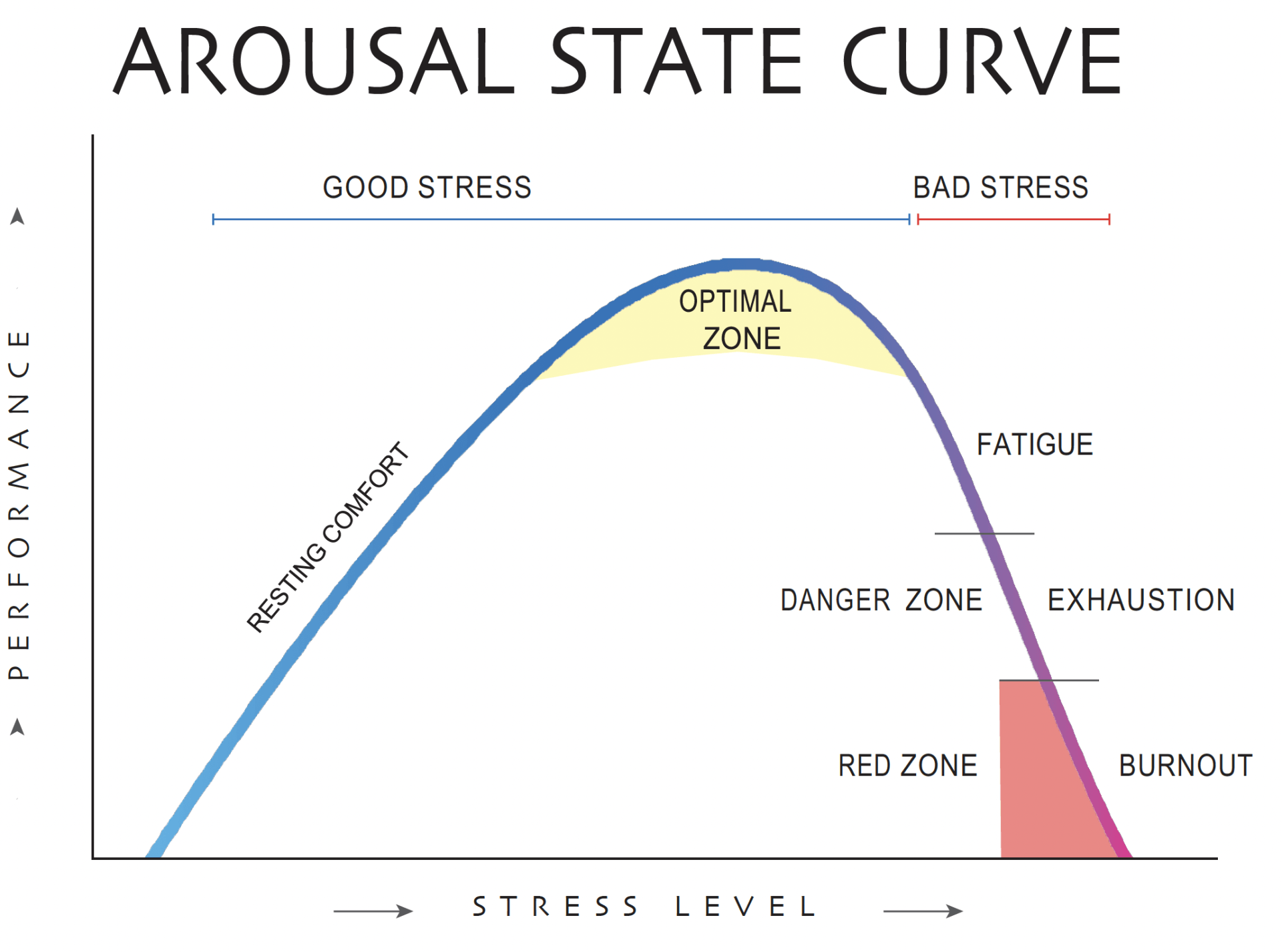Good Stress heals and builds, providing the vigor and focus to do things benefiting ourselves and others.

Stress is part of life and is hardwired into our being. Managing it is an essential skill for effectively handling the opportunities, the trials and the tribulations encountered in aging. Good Stress heals and builds, providing the vigor and focus to do things benefiting ourselves and others. Bad Stress is destructive, endangering our health, our body, our mind and relationships with others.
Stress comes through the mind responding to what we perceive and feel. Activating processes throughout the body that raise and lower levels of arousal. Effects that are sensed as changes in alertness, energy, and tension. Stress is the strain arousal puts on the body and mind. Good stress is strain that is healthy and often enjoyable. Bad Stress is unhealthy strain and is miserable. Here we examine the nature of stress. What makes the difference between Good and Bad stress and how we can work to keep it Good.
Bad stress is especially dangerous in aging as it increases the risk for serious illness and injuries. There has long been awareness of this as illustrated in a passage from Psalms 31 written more than 2200 years ago.
Have mercy on me Lord, for I am in distress.
My sight is blurred because of my tears.
My body and soul are withering away.
I am dying from grief.
My years are shortened by sadness.
Misery has drained my strength.
I am wasting away from within. 1
This ancient lament captures the essence of Bad stress. Stress that Dr. Hans Selye recognized was a common cause for severe illness afflicting many of his patients.. His landmark study published in the journal Nature in 1936 proposed that stress affects health by placing overwhelming demands on the body and mind.2 Since then there have been over 39,000 publications in the medical literature documenting high levels of continuous stress as a major contributor to the development and progression of disease.3 Much is now known about how Bad stress accelerates aging processes. How it can profoundly increase disease severity, and lead to premature death.4,5 And how in contrast, balanced levels of low, moderate, and brief periods of high stress are vital for good health and wellbeing.6
Stress can be measured by the level of arousal generated by the release of stress hormones in the brain’s response to perceived opportunities and threats. An essential brain site regulating stress levels is the amygdala that continuously monitors activities requiring changes in arousal levels. The amygdala is a collection of nerve cells in the temporal lobe of the brain that integrates sensory and emotional information coming in from all parts of the body with memories of past experiences. The threat level of current events is assessed based on past experiences with similar situations. Those that were pleasant and safe decrease levels of arousal and promote ease. Those that evoked fear stimulate the Amygdala to increase arousal levels to handle the threat. For example, driving in a snowstorm in heavy traffic can be fearful, especially if you had past accidents in similar conditions. Arousal levels are high and can lead to fatigue and exhaustion on a long trip. However, when friends are in the car on a road trip on nice day, the experience can be enjoyable with arousal in the good stress range.
Stress Hormones are Powerful Drugs
Stress hormones belong to the large number of natural, biologically active molecules made by cells in our body (our internal pharmacy) that regulate growth, development, and homeostasis while also combating infections, and promoting healing. They are not only made by our body, but they can also be manufactured as drugs for medical use. The major stress hormones adjust changes in arousal levels from low levels we sense as comfortable to higher levels that can promote performing at our best - being in The Zone as athletes call it. When sensing very dangerous threats like a fire burning in the house, the amygdala signals the hypothalamus to release very high levels of stress hormones evoking the physiological Fight or Flight Response. Immediately we are alerted to take action, either to fight the fire or run away as fast as possible.
Effects of Stress Hormones on the Body
- Epinephrine and closely related norepinephrine produce the “adrenalin rush” at high levels of arousal, focusing the full attention of the mind on what’s happening. Vision and hearing go on full alert, the heart pounds faster, and breathing rapidly increases to provide more oxygen to the body. Blood vessels constrict and blood flow is channeled to supply the brain and muscles. Digestive processes are paused to put the body’s full efforts into taking actions to respond to the threat.
- Medically, the drug Epinephrine is used to treat severe allergic responses (such as by injections with an Epi Pen) and cardiac arrest.
- Medically, the drug Norepinephrine is used for managing low blood pressure during surgery and in some medical conditions.
- Cortisol from the adrenal cortex provides the energy needed for fighting or running by raising blood sugar levels.
- Medically, the drug Cortisol is used to treat conditions such as arthritis, blood/hormone/immune system disorders, allergic reactions, breathing problems, certain skin disorders, and some cancers.
- Vasopressin contributes to constricting blood vessels to raise blood pressure and conserving water through actions in the kidneys..
-
Medically, the drug Vasopressin is used to treat septic shock and to increase blood pressure. It is also used to treat
diabetes insipidus that leads to dehydration due to the inability of the kidneys to concentrate urine.
- Oxytocin released from the pituitary gland has significant stress-protective actions. It is also an anti-inflammatory agent and promotes healing. Importantly for the survival and reproduction of our species, oxytocin promotes bonding and working cooperatively with others. It is found in high levels in romantic couples leading to one of its nicknames “the love hormone”.
- Medically, the drug Oxytocin has complex interactions in the body and can have pronounced side-effects. It has been difficult to convert into a therapeutic drug.8 It is best to let your internal pharmacy dispense Oxytocin as needed by your body and naturally increase levels by being more loving and caring for others.
STRESS, AROUSAL, AND PERFORMANCE
Again, stress and arousal are tightly linked. Arousal is the level of physical and mental activity of our body and mind - the amount of energy being used. Stress is the strain placed on the body and mind by this activity. While the amygdala is always adjusting blood levels of stress hormones to regulate our level of arousal, we normally only recognize the arousal levels as “stressful” until they are high. The stress placed on our body and mind by arousal can be measured by the quality of our performance. The relationship between performance and arousal is depicted in the Arousal State Curve (Figure 1). The horizontal line shows stress levels with increasing arousal states. The vertical line is quality of performance.

Figure 1. Increases of Stress Hormones Increase Arousal Level: Both high performance
levels and health benefits come from short bouts (minutes to hours) of arousal in the optimal
zone followed by relaxing back into the comfort-resting zone range. Prolonged high levels of
stress hormones cause Bad Stress. Over time Bad Stress leads to increasingly serious health problems.
The dose of stress hormones released by the hypothalamus and their duration at high levels in the blood determine the goodness or badness of stress on our bodies. All stress drugs, both those dispensed by our hypothalamus and the same chemicals manufactured as drugs have a definitive dose-response curve. Doses too little are ineffective and doses too high can also be ineffective. All drugs can cause serious side-effects, especially at higher levels. Prolonged high levels of stress from high levels of stress hormones lead to exhaustion, burnout and illness.
The internal dispensing of stress hormones is an autonomic response regulated by Amygdala – Hypothalamus interactions. However, our conscious nervous system can modify the stress response through cortical connections with the Amygdala. The internal dispensing of stress hormones is graded to adjust arousal levels. A pleasant meeting with friends is a comfortable event requiring just sufficient levels of arousal to be alert and interactive. Giving a formal presentation, playing music for an audience, or competing in a sport requires being at your best mentally and physically – in your
optimal zone. Athletes often say they are in the
zone when they are playing well.
Bad Stress comes from pushing yourself or being pushed by circumstances to into prolonged periods of continuous high stress. It happens in many jobs and personal situations. The duration of exposure to high stress is a critical factor. Short periods of stress in the Optimal Zone lasting minutes to hours, whether psychological, physiological, physical, or from exercise, can be Good stress that is healthy when followed by sufficient time for recovery. It strengthens immune and heart functions and improves cognitive and physical fitness.
What I want to emphasize is that stress is a Mind thing and through our Mind we have ways to manage it. Cultivating Good Stress is an art. The skills that work best vary from person to person. We will cover some of the most effective ones in future Posts and in the Resources section. Let me leave you with a strategy that helps many. Begin by identifying activities that are causing stress that can be reduced or eliminated. For instance, watching the news on television is often aggravating. The news typically depicts the worst of the worse that has happened. If it bleeds, it leads the broadcast. The loud sounds, disturbing images and short sound bites are designed to raise arousal levels. To reduce the stress, limit the time spent on TV to a minimum, instead read news reports and spend more time on more pleasurable activities.
Another example comes from a good friend who loves to play bridge. She belonged to six groups that played regularly. Five were very enjoyable. One was not because of the chronic negativity of some of the players. She tried but could not change the tone in this group, so dropped it. Instead, she volunteered to teach a novice group of players how to improve their skills. This turned out to be a positive experience, working with others that appreciated her help . Paring down bad stressors is an important skill. Finding satisfying replacements adds to the Good Stress accrued in doing so.
_________________________________
The Author: Don Gash is an emeritus professor of Neuroscience (PhD) in the College of Medicine and Lewis Honors College at the University of Kentucky. His expertise is in drug development for diseases of aging, especially those effecting the brain. Over fifteen years ago, he recognized that aging poses serious threats to health and wellbeing – and has many features of being a disease. Dr. Gash felt that his experience in developing therapies for neurological diseases could be used to better understand normal aging processes and ways to promote successful aging. Ways that activate natural healing processes in the brain and body to effectively restore true wellbeing. Lifestyles and practices that do not replace good medical care when needed, but make it work better. The advice given is evidence-based on published studies including his and from years of personally testing many programs and exercises to identify those which effectively cultivate and enable Aging Successfully.
Sources
PubMed identification numbers (PMID) are given for peer-reviewed scientific reports in mainstream science journals. The scientific papers are available online through PubMed on
www.nlm.nih.gov.
1. Psalm 31: 9-10 (New Living Translation, 1996)
2. Selye H. (1956) The Stress of Life. McGraw-Hill Book Co. New York
3. Cohen S et al. (2012) Chronic stress, glucocorticoid receptor resistance, inflammation, and disease risk. PNAS 109: 5995-5999. PMID: 22474371
4. Epel ES et al. (2004) Accelerated telomere shortening in response to life stress. PNAS 101:17312-17315. PMID: 15574496
5. Keller A et al. (2012) Does the Perception that Stress Affects Health Matter? The Association with Health and Mortality. Health Psychol. 31: 677-684. PMID: 22201278
6. Dhabnar F. (2018) The short-term stress response – Mother nature’s mechanism for enhancing protection and performance under conditions of threat, challenge, and opportunity. Front Neuroendocrinol. 49:175-192. PMID: 29596867
7. Sonne J and Gash D (2018) Psychopathy to Altruism: Neurobiology of the Selfish-Selfless Spectrum. Front. Psychol 9:575. PMID: 29725317
8. Carter CS. et al. (2020) Is Oxytocin “Nature’s Medicine”? Pharmacol Rev. 72:829-861. PMID: 32912963
All Rights Reserved | Aging Successfully







